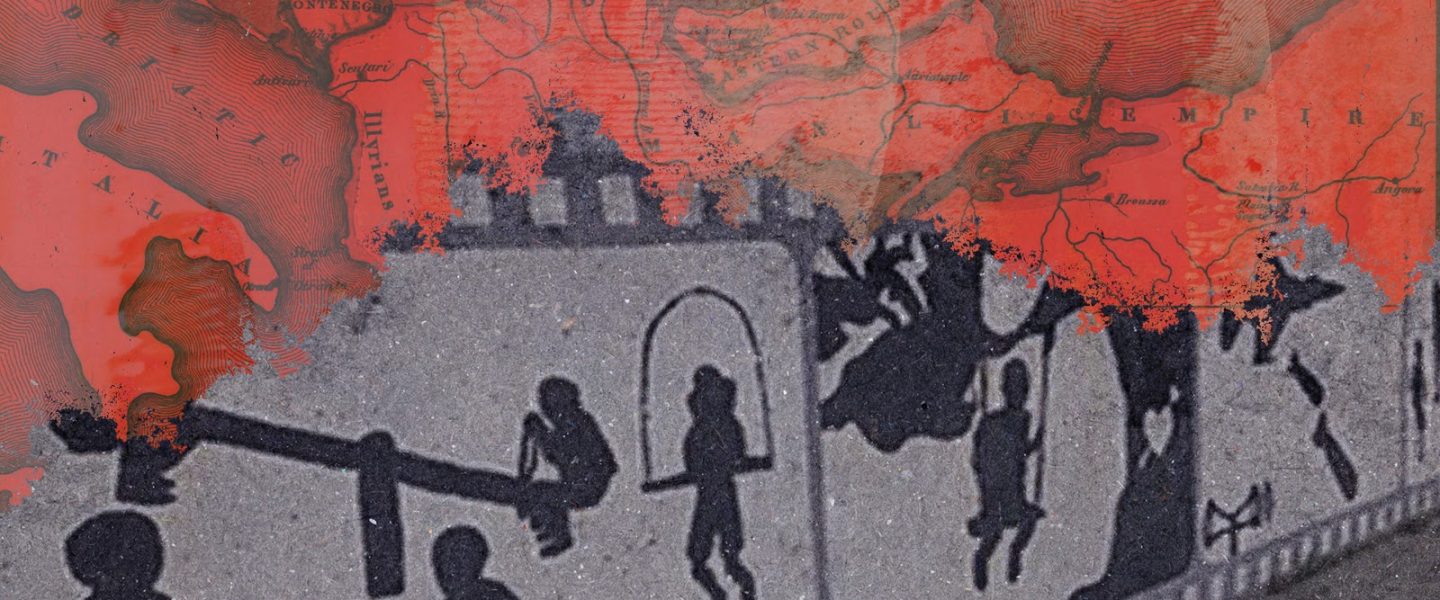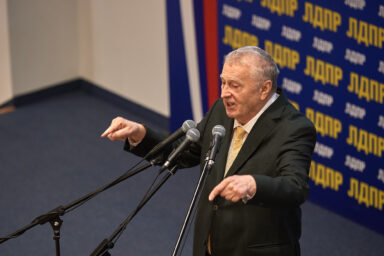In Slavonski Brod, Croatia, healing the wounds of war has been difficult, but so too has been dealing with the shock of free market economics and living within the European Union.
WhoWhatWhy is partnering with Global Geneva, where this story was originally published, to help expand access to content that will benefit a broader global readership.
Mladen Vladetić (below) is standing in his old local park. It is called the “blue field,” and it is surrounded by grim-looking tenements, their outer walls still scarred by shell impacts with great holes and scratches gouged out of them. There are swings, a slide and a small roundabout, connected by pathways overgrown with moss and weeds. As you approach, you notice a wooden sign and then a concrete plinth with inscriptions on them. “In remembrance of the killing of children on this playground,” reads one. The other makes a wider point: “Children are only one-third of mankind but they are our whole future!”
It was a sunny day in early May in 1992 that Vladetić, then aged 13, decided with three of his friends to leave the playground for a change and head out of town on their bicycles to some old quarry pits to go swimming. It was while they were there that they heard the sirens, but they had no idea what was happening.
That day, a mortar shell came crashing through the trees and detonated in the playground, killing three of Vladetić’s friends and wounding several others. Assuming that he had been with them, his parents were beside themselves as they waited for news of their son. “When we came back, the whole town was so spooky and quiet. And when we arrived, our parents were screaming and yelling and hitting us and kissing us all at once,” remembered Vladetić. “It was an incredible moment of relief and anger. Of course there were no mobile phones then, and everyone had been wondering where we were.”
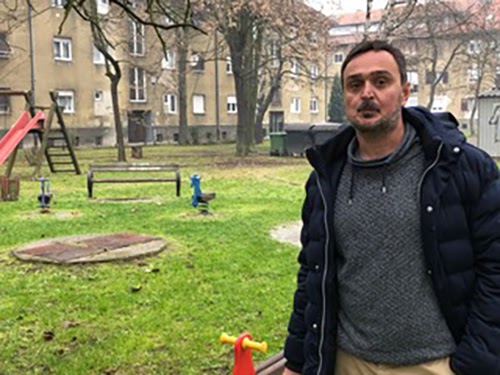
Given what he had gone through as a child, Vladetić, a jolly, bearded character with owlish features, has done remarkably well to put the war behind him and focus on his future with his partner Antonia, alongside their two-year-old daughter, Vida, and his three stepchildren. But I was to discover that not everybody in Slavonski Brod has been able to move on.
Twenty-seven years ago, when I last drove the 120 miles on the deserted trunk road from the Croatian capital, Zagreb, southeast to Slavonski Brod on the border with Bosnia, the ticket office for the toll system was still working at the Zagreb end. But, when my traveling companion — the famed American writer and satirist P.J. O’Rourke — and I turned off for our destination, we found that the toll booths at the péage area had been blown to pieces. It was a free ride for us, but the price for the locals was high: Croatia was at war.
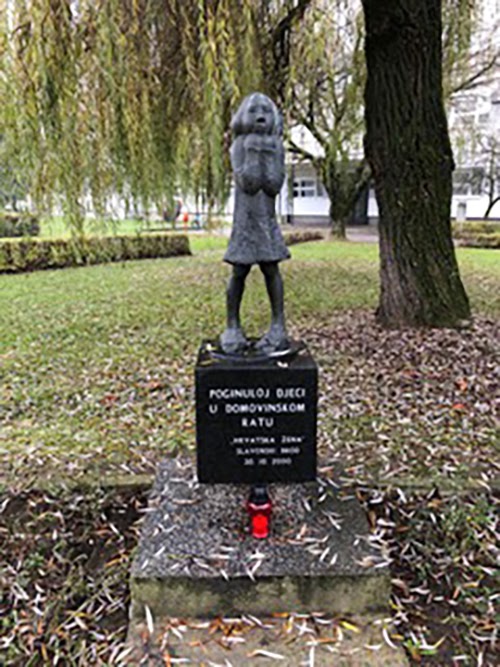
The Biggest Loss of Children in the Balkan Wars of the 1990s
But on my return there late last year, the road was busy, even in the dense fog of a damp December evening. And the ticketing system was working, much as you would expect in any efficient and modern country in the EU. Having handed over my Croatian kuna to the clerk in the booth, I made my way into Slavonski Brod, today a town with some 60,000 people, for the first time in nearly three decades. It was an unnerving feeling.
The last time I was here, the city on the banks of the Sava River was half at peace, half at war. It was well on its way to becoming one of the most consistently shelled population centers in the tragic tapestry of the modern Balkan Wars, thanks to Serb gunners across the river in Bosnia. For six months in the spring and summer of 1992, they delivered mortar rounds and rockets on a daily basis into the center of what had been one of old Yugoslavia’s most prosperous places in a bid to terrorize, kill, and wound its mainly Croat inhabitants.
During those months of bombardment, thousands of projectiles landed in the city and in the villages on its outskirts, injuring thousands and killing around 300 people, 28 of whom were children. It was the biggest loss of children anywhere in the wars that followed the breakup of the old Yugoslavia.
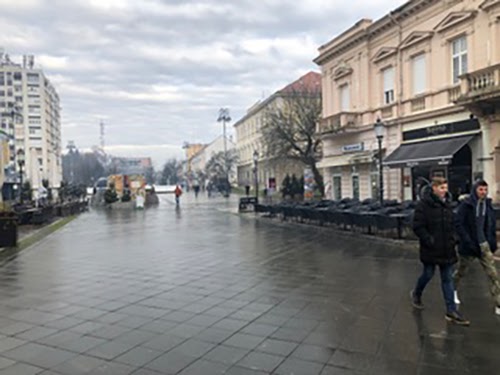
Waiting for the Audible Click of Detonators
No one who visited Slavonski Brod in those days will forget what P.J. called the “intense, prickly, almost smellable silence” during daylight hours, as people waited for the next barrage to begin. The air would be filled by the mournful wail of air raid sirens and then everyone would wait for the audible “click” of a detonator somewhere across the border. People got into the habit of counting to five under their breath and hoping that the next shell wasn’t coming for them.
A typical eastern bloc mixture of old Austro-Hungarian grandeur and concrete communist brutalism, the city would echo to the “crump” of a mortar or rocket landing at random on a road intersection, an apartment building, on someone’s house or in the shopping district. Then the ambulances would be sent out.
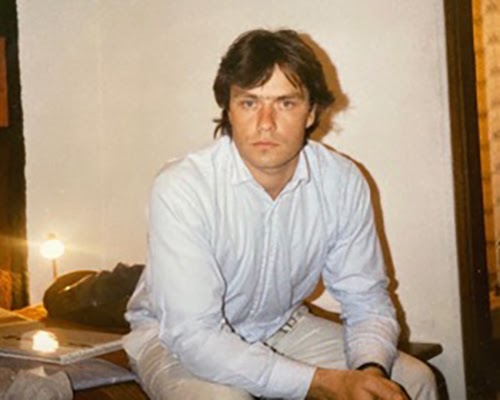
In those days — well into the Serbo-Croatian War and the developing conflict in Bosnia — Slavonski Brod was a popular spot for visiting journalists. Unlike the Bosnian capital, Sarajevo, it was not cut off under siege, and you could still get in and out relatively easily. Ours were typical of the itineraries of Western correspondents being sent in to try to understand and report on one of the most complex wars in human history and the only full-scale conflict to stain modern Europe since 1945. I spent a day and a night in Slavonski Brod before moving on to another hotbed of violence at Bihać in Bosnia and then visiting Sarajevo itself.
During our brief stay, P.J. and I made a whistle-stop tour of the city. We checked in on Frano Piplović, the leader of the town council who had had to move his offices out to one of the nearby villages for the safety of his employees. We met Ivan Balen, the administrator of the hospital where 10 makeshift operating theaters were working around the clock in the corridors in the basement. And we stopped at the Arcade Bar opposite the hospital where, behind its sand-bagged windows, Vinko Barisic, the ponytailed manager, was serving stiff drinks and loud rock music to wounded soldiers.
I hadn’t thought about Slavonski Brod much in the years since. It was hardly the epicenter of the wars in the old Yugoslavia, a part of the world that will be forever scarred by the horrors of “ethnic cleansing” and the atrocities and massacres that took place in towns such as Srebrenica, Vukovar, or Sarajevo. That was until last summer when I returned to Croatia for the first time since the war, having been invited for a week of sailing on the Dalmatian coast.
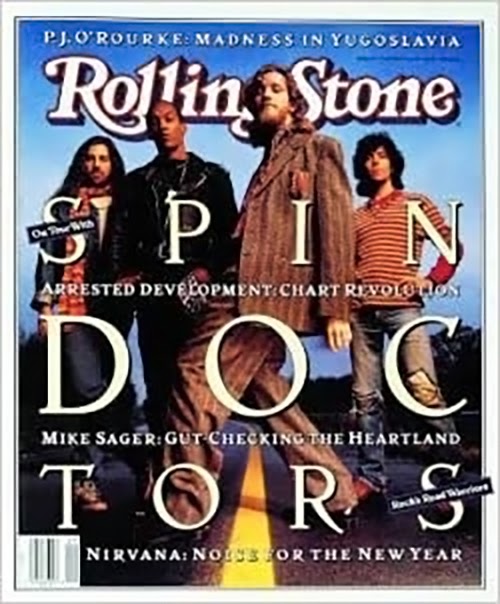
Our boat came with a skipper, and when I met him, I naturally inquired where he was from. “Oh, it’s a place you probably won’t have heard of,” he said. But of course I had, and Mladen Vladetić and I talked at length, comparing notes on what had happened in his hometown. A great ambassador for his city, it turned out that Vladetić knew Ivan Balen — he had played football with his son — and Vinko Barisic was a childhood friend. He knew where to find Frano Piplović and he had other ideas about people I should meet if I ever went back. Vladetić offered to guide me and translate for me and made it clear I was welcome any time.
We followed each other on Facebook, and several months later he posted a video on his page made by the Slavonski Brod tourist board extolling the virtues of the city, complete with drone footage of the town and stirring patriotic Croatian music. I was curious. I wanted to know more about what had happened there — I’d been in too much of a rush the first time — and I was curious too about what had happened since the war. Slavonski Brod was now part of the Europe we in Britain are leaving. It had made the switch not just from peace to war but from Marxism to free market capitalism and from communism to individualism. How on earth had its inhabitants handled all of that?
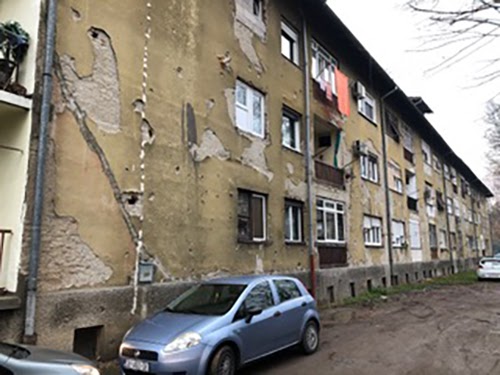
Vladetić and I are sitting in the upstairs room of a dilapidated townhouse not far from the city center. It is the home of an association for relatives of those killed in the city who meet every week to talk together and often cry together about events that destroyed their lives all those years ago.
Ana Pejanović, aged 72, breaks down as she recalls the death of her eldest daughter, Melita, who was hit in the head by shrapnel just a few days before I arrived in the city. She was taken to the hospital and died there on the day P.J. and I toured the emergency operating rooms in the basement. A former railway technician, aged 20, she had been in Germany for a few months and had come back looking for work. Her younger sister, Ivana, had suggested they spend the day visiting a friend in a part of town that they considered relatively safe from the bombardment. But, upon their return Melita was mortally wounded by a shell that exploded on the street in front of them, while Ivana escaped unscathed.
“I don’t even like to speak about it with my younger daughter because when it happened it was Ivana who took Melita to the hospital, and she has always blamed herself for this because she was the one who said, ‘Let’s go to that place,’” said Pejanović. “It was especially bad for Ivana because when she got to the hospital it was she who heard the doctor say that Melita had no chance of survival.”
Sitting next to Pejanović, Julijana Rosandić, aged 67, has an equally harrowing story to tell. A couple of weeks before the outrage at the “blue field” playground, she and her husband were leaving town at the weekend taking their two teenage boys to a place of safety in the countryside, when their car suffered a direct hit by a mortar shell.
Her husband was severely injured in the explosion and has been an invalid ever since, while both boys were very seriously injured but physically, at least, have since recovered. “We will never forget it — of course, life goes on, and I have my kids to take care of. But even now it is hard to talk about it because it brings back the memories,” said Rosandić in a tired voice without much variation in tone. “The worst experience for me as a mother was watching my child in hospital on a respirator for 42 days and not being able to help.”
Rosandić is angry at the way the town authorities took many months to order the permanent evacuation of schoolchildren — in the end, 13,000 were sent out — and at the failure of the government to compensate her and her family for their injuries and loss of livelihood. What grieves her most is the failure of the Croatian government to make any effort to bring the Serbs who mutilated her children and husband to justice.
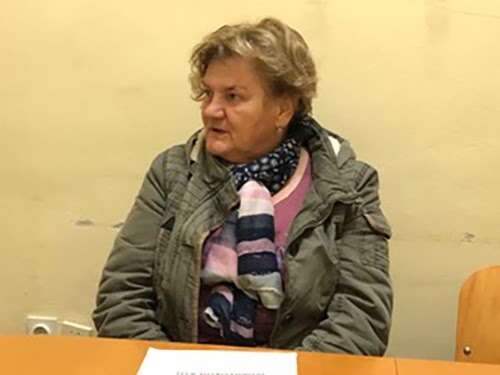
But she holds no grudges against ordinary Serbs who were her neighbors, a few of whom still share their daily lives with her in Slavonski Brod. (They now represent about 4 percent of the city’s population, down from 12 percent before the war.) “I don’t hate anybody, I don’t know who to hate,” she said. “When my family was attacked, my boss at that time was a Serb, and he came to the hospital and said, ‘Forgive me,’ and I told him he was not to blame. We had a perfectly normal life with the Serbs here who were not shooting at us, and I don’t blame them for what happened.”
It is easy to get obsessed with the past in Slavonski Brod. The damage to the buildings reminds you of what went on there as do the many monuments around the city, especially to the children who were killed. But most of its residents are trying to focus on what many hope is Croatia’s bright new future as the EU’s newest member state, having joined in 2013.
EU Membership: Good for Some, Bad for Others
The journey from war to the European Union has been far from easy, though. The conflict exerted a profound and lasting shock on the newly independent nation and on Slavonski Brod, which went, in short order, from being one of Yugoslavia’s most prosperous towns to one of Croatia’s poorest. Almost all the old state-owned conglomerates in the city — including Duro Daković, the vast heavy engineering works — collapsed or dwindled, and unemployment skyrocketed in the postwar years to up to 50 percent in a city of 50,000 people.
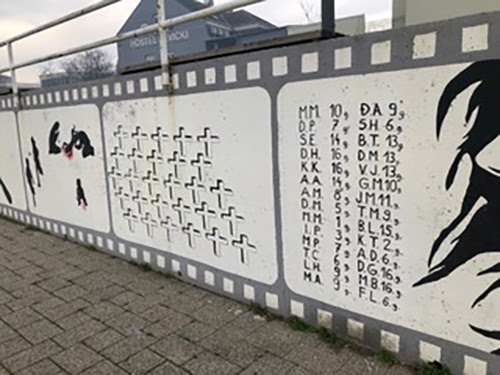
At the same time, the town had to accommodate up to 20,000 refugees from the fighting in Bosnia, while losing thousands of its most talented people who left for jobs in Zagreb or in Germany and Austria. Among them is Vinko Barisic, who now lives near Stuttgart where he works as an artist and as a manager for Hugo Boss. Half-jokingly, he told me on the phone: “It is not the same town as it was before because all the good people, like me, have left.”
You may think that the advent of the free market could be only a good thing for places like Slavonski Brod, but people have made the transition slowly, and they are still making it. In the early years after the war, privatization swept through the city, but alongside it came its ever-present Balkan stablemate — rampant corruption. This has enriched a tiny elite, regarded by many as criminals, leaving the masses struggling.
In a bar by the banks of the Sava, Frano Piplović, now 69, bemoans the rape of the Croatian economy by its new capitalist class. “There is hope and a bright future for one part of Croatia — for those who are corrupt and have stolen money,” said Piplović, who became a Croatian consul in Banja Luka in Bosnia after the war. “They have all the best companies and the best land and they have the power. But they have a huge problem — a lot of people are emigrating, and nobody wants to work for them.”
Looking back to the days when he ran the council, Piplović thinks of the war and the collapse of the communist economy as a “historic crash” when everything fell apart, socially, politically, and economically. “There were huge consequences for the people,” he said, “nothing was normal, and the consequences are still felt today.”
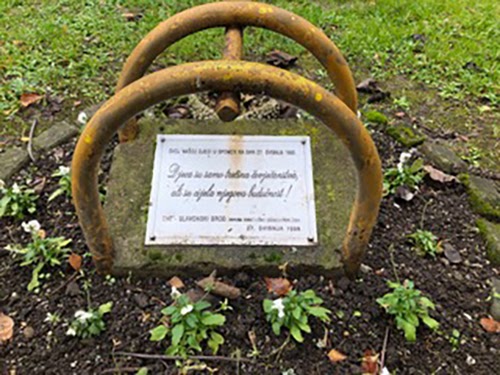
But not everyone views the glass as half-empty in Slavonski Brod. EU membership is starting to make an impact, and standards of living are creeping up, something many believe is helping to mitigate the ever-present and deadly tendency among people in this part of the Balkans to look backward to injustices of the past instead of forward.
Petar Bašić, a local independent politician, says Croatia is taking time to learn how to use European structural and social funding. But he believes the business and political classes are slowly coming to understand that all EU monies have to be accounted for, down to the last kuna, and kickbacks are a thing of the past when it comes to EU grants.
“People cannot get payoffs and that is one of the reasons why we do not write enough European-funded projects,” he said, cigarette in hand over coffee in the Arcade Bar, now renamed and refurbished. “At the moment, we are using only about half the EU money that is available and in Slavonski Brod only about 5 percent of the money.” He gave examples of local investment schemes that could attract substantial funding but which have stalled because the people running them lost interest once they realized there was no prospect of taking money off the top.
But Bašić is optimistic about the future, and he fervently believes that EU membership is helping to reform Croatian business and public life. “The best thing about entering the EU is that Brussels forced us to reform things that we should have done ourselves but that we hadn’t — first of all, the judiciary and then corruption.”
Bringing About Change With a More European Identity
Bašić also believes the EU can help ensure that the Balkan Wars remain a ghost only of the past. While many in Slavonski Brod would not welcome Serbia’s possible accession to the Union, he thinks it can be an insurance policy against any further outbreak of violence in the region. “It would be the final touch that we have never had for hundreds of years,” he said. “It will protect the Balkans from another Serbian aggression. Many Serbs who were our enemies have not changed, but they would if they came into the EU. That would bring them prosperity — more money means less talk about nationality, religion, and war.”
My final encounter was with Ivan Balen who, I discovered, was not just the hospital administrator during the war but is also a gastroenterologist and a professor of internal medicine. A charming man who chain-smoked when I met him in 1992, he has returned to his old habit in retirement after a 15-year hiatus. He was fascinated when I showed him P.J.’s article about our visit to the city in a January 1993 edition of Rolling Stone in which he was quoted as saying: “Everything is sad and terrible.”
Balen lived for three days at a time in the hospital basement organizing the treatment of more than 6,000 wounded people in 1992, about 30 percent of whom were from the city. During that summer, the hospital took 21 direct hits, and four of its staff were killed.
Now in his 70s, Balen spoke quietly but firmly about a period in his life of which he is justly proud. He was amazed at the way ordinary people coped with the stress of being under attack. “Most people were incredibly brave and handled it quite easily, given the situation they were in,” he said. “Even when you are expecting war, it is like a nightmare when it happens. But it is incredible how 90 percent of the people just adapted to it. When you look back, you can’t believe how strong they were and how they got through it and then returned to normal life afterward.”
The current president of the local football team, Balen says he would never like to go through the experience of war in Slavonski Brod ever again. Like Bašić, he feels hopeful about the future for his hometown. “I am very positive on the EU, but we are still cooking in the Balkan pot,” he said, with a twinkle in his eye. “But I’m not worried about more war.”
Journalist and author Ed Gorman worked for the Times of London for 25 years as a foreign news correspondent, sports writer, and desk editor. He specialized in the Soviet and later civil wars in Afghanistan. He also covered the war in the former Yugoslavia and was then based in Northern Ireland for over four years during the Troubles. Leaving the newspaper in 2013, he has worked on various e-books, including Death of a Translator about his reporting experiences in Afghanistan and his diagnosis with PTSD. (See his Global Geneva article: Death of a Translator — Putting PTSD on the Front Page”). He lives with his wife, Jeanna, in West Sussex in the UK.
Related front page panorama photo credit: Adapted by WhoWhatWhy from Bracodbk / Wikimedia (CC BY-SA 3.0).
